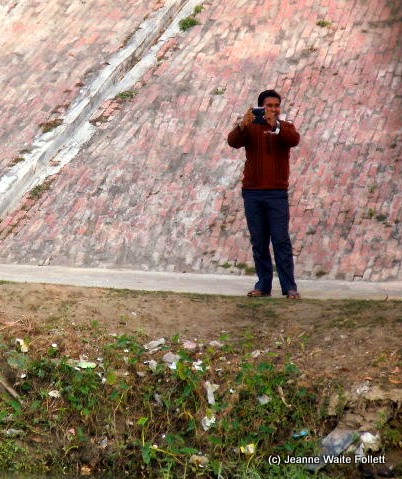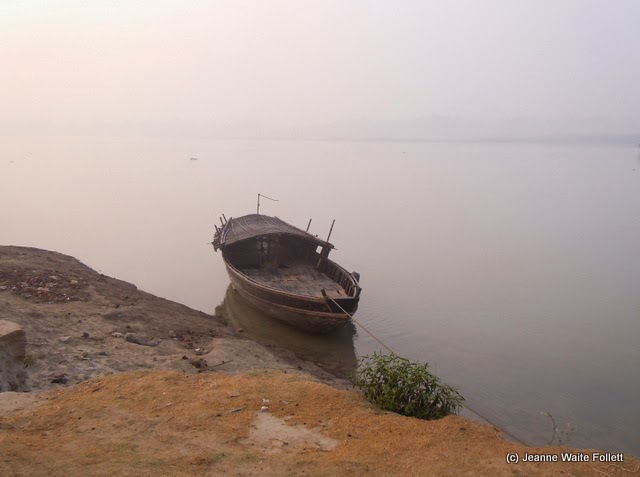Ch. 13, Bathing in the Waters of the Sacred Ganga
Perhaps
travel cannot prevent bigotry, but by demonstrating that all peoples cry,
laugh, eat, worry, and die, it can introduce the idea that if we try and
understand each other, we may even become friends.—- Maya Angelou
I
bathe in the waters of the sacred Ganges River. My food is prepared with those
waters, my dishes cleaned in it, my linens washed in it.
Each morning Ganga
water runs through my hair, onto my shoulders, and down the rest of my
body. It is cleansing and refreshing.
I don’t drink it,
though, not on my life. Unlike the third
of India’s population that lives along the river and its tributaries, my
Western body is not immune to the pollutants the Ganges gathers and carries
along on its voyage to the sea. Why
then, you might ask, why would I bathe in it and eat food prepared with it?
Because there is a water
treatment plant on this riverboat, that’s why.
The shipboard water comes from the Ganges and passes through that
treatment plant before it reaches me.
Most likely the water from the plant is perfectly fine, but there are—at
the moment of this writing―six bottles of spring water in my room, generously
supplied by Viking, or by Haimark, the owner/operators of the RV Ganges Voyager, so why take the
chance that my foreign and fickle constitution might find something in the
water to which to object?
By the way, that bottled water is sold under
the label Kinley, a Coca-Cola
company.
If I use a bottle of
water, it is replaced immediately. More
bottles are available in the dining room, the lounge, on the country boat, and
in the buses and coaches that transport us on land. So while I bathe in the sacred waters, I
don’t drink them.
The Ganges, known as
Mother Ganga to Indians, is birthed high in the northern Himalayan mountain glaciers and snow fields and
flows south into India and east to the Bay of Bengal, a journey of 1500
miles. It has many arms and tributaries,
joining the Hooghli River near Kolkata, the portion of the river that we are
now on.
For the locals, the Ganges is life-giving and life-sustaining. Each day of this voyage, I see hundreds of
people bathing in the river. Men and
women bathe separately in most cases, and their bathing places usually are
separate. Men bathe in shorts or
loincloths; women are fully clad, though barefoot.
 |
| Planting rice in the river shallows. |
 |
| Man in a nauka. |
I see men herd cattle
to the river to drink. I see women beating
clothing on rocks and swishing the clothing in the water to rinse them. I see drying clothing hanging from bushes,
fences, balconies, wherever.
 |
| Mustard fields in bloom. |
 |
| I was pretty fascinated when a man drove these water buffalo into the river. The animals knew just what to do. |
 |
Raw sewage, corpses both human and animal, all matter
of disease-causing bacteria impact the water, and it is considered one of the most-polluted rivers on earth. Yet religion decrees the Ganga is
holy and purifying to the soul, while every day dozens of children die of diarrhea.
 |
| Once in a while, someone on shore "shoots" back. |
But the Ganges is
important for another, critical reason:
it is the arterial system of northern India. Goods are hauled to market on small,
double-ended boats called naukas. The little black boats range in size from
about 12 to 30 feet and are flat-bottomed or have V hulls. Some are passenger ferries with places for
sitting; some have bamboo platforms and carry larger freight.
 |
| Mustard in bloom next to corn field. |
 |
| Sugar cane |
 |
| Village children gather to watch the big white go by. |
 |
| Cattle drinking the river water. |
On the river at
Mayapur, a large bamboo raft was tied up to shore, no doubt used to transport
goods for the bazaar outside the Hare Krishna temple.
Attempts have been made
to clean up the Ganges. One failed for
reasons of corruption. Under the new and
ambitious prime minister currently in office, another project is taking shape
under a two-year planning phase which hopefully will lead to a 20-year
implementation phase.
 |
| Silt is dredged from the river bottom and carried in floating pipes to a nearby brick factory. |
 |
| Smoke from kilns drying bricks adds to the air pollution and constant haze. |
In the meantime, the
ubiquitous foam plates float by, often captured by the hyacinth plants
floating in the river. Downstream around
Kolkata, there are large rafts of floating hyacinth, with debris intermixed.
The hyacinth, said a
woman on board who has traveled in India extensively, is invasive
everywhere. It has so taken over the
Congo River in Africa that massive amounts of funds are expended in trying to
keep that waterway open for navigation.
The Congo has the missionary nuns to thank for that infestation of a
non-indigenous plant. A little reminder
of home in Florida now costs millions to keep the waterways clear.
However, she said,
hyacinth purifies the water. Nowhere
near enough hyacinth for the Ganges, though.
 |
| Hyacinth growing near these unused barges. |




















I look forward each day to see where I am on the Ganges and to wave back to the people standing on shore. Glad you are not drinking the "treated water" ... Cap also makes it a rule in India to NOT bathe above the neck with other than bottled water. He got an eye infection on his first trip in 1990 and it still flares up. Thanks for another day in India... Patti and Cap
ReplyDeleteThe Delta near San Francisco Bay has the same problem with the hyacinth. Some marinas are closed to boating because there isn't enough money to clear them all out.
ReplyDeleteI just about flipped out when I read at the beginning of this post about all you do with the river water! THEN you advise us that your ship has a water treatment plant and I said wonderful BUT keep drinking all that Kinley (Coca Cola) bottled water. I like the Kinley brand of water and the quality of the plastic bottles it is bottled in. So HAPPY at the end you DID state that among other things in the river are human and animal corpses! Many of the photos are identical to those scenes you view from trains in India. People out watching the train pass by knowing that probably they themselves will never ride a train. Even more pertinent to a luxury ship that you were on since I MYSELF will probably never sail on such a fine water vehicle. I am enjoying my 93 square foot studio in Hong Kong thinking about you and about your large (up to 260 square feet) rooms. I am loving seeing India through your eyes.
ReplyDeleteCap from Hong Kong and Patti wishing she was with me in Hong Kong (me too) ..
I love the brightly colored clothes I see on the people of India. I often think that people in poor countries wear rags but that seldom seems to be the case.
ReplyDeleteI suppose it would be impossible for the boat you're on to carry all the water needed so they wouldn't have to depend on the river. Thank God the maiden voyage proved the water filtering system to be working effectively. Or was it? Have you been to the doctor or are you feeling normal again?